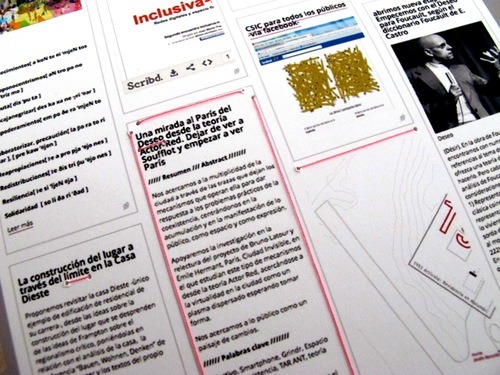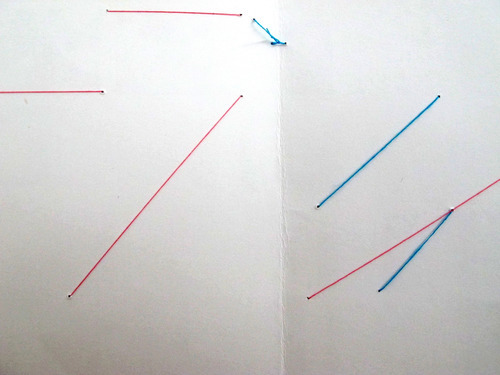Campo adentro es uno de los proyectos artísticos más interesantes actualmente en nuestro país. Nació en 2010 como una plataforma de investigación sobre arte, agricultura y medio rural, y se ha formalizado en residencias para artistas, debates y exposiciones como la que ahora llega a Matadero Madrid. Hablamos con el responsable, el artista Fernando García Dory, sobre el campo, la ciudad y la naturaleza. También interior.
 Fernando García Dory. Foto: Cristina Rocha
Fernando García Dory. Foto: Cristina RochaSu último proyecto, Campo adentro, que inició en 2010, se relaciona directamente con ello. Han sido tres años en los que ha tenido lugar una conferencia internacional, una fase de producción con un programa de residencias en 12 comunidades autónomas con 22 artistas en total y presentaciones y exposiciones como la que hasta el domingo presentan en Matadero Madrid. Representa quizás el final de una etapa y el comienzo para él de investigación de nuevas formas y campos. "Hace poco, hablando con una comisaria, me decía que el proyecto le parecía más cercano al Artists Placement Group - APG de Latham y Steveni en los 70, o a la idea que lleva a Boetti a regentar el One-Hotel donde invita a otros artistas a explorar ese rincón en la periferia que era Kabul", dice.

Campo adentro en Matadero Madrid. Febrero, 2013
Campo a través
El nombre, Campo adentro, remite a un lugar físico, mar adentro, lejos de la costa, un paisaje inestable, y otro psíquico, interior, a los adentros, un territorio lleno, también, de corrientes variables. El proyecto reflexiona sobre la idea de territorio, geopolítica, cultura e identidad en las relaciones entre campo y ciudad en España. Mucho tiene eso que ver eso con que Fernando García Dory haya crecido entre las montañas de Cangas de Onís, en Asturias. "Siento una enorme gratitud y admiración hacia la gente del campo. Hay verdaderos monumentos trabajando allí, de una dignidad y grandeza sin pretensiones, como árboles viejos", dice.El suyo es un perfil de artista singular, algo atípico. Trabaja sin galería, el capital que más valora es el simbólico y entre sus últimas piezas hay una pequeña producción de quesos artesanales. Aunque su relación con el lácteo viene de lejos. En 2010, como cierre de una Conferencia Internacional en el Museo Reina Sofía, organizó Agri-Cultura 1, un mercado de quesos en la Cuesta del Moyano, en intercambio con los libreros. Hace menos, el pasado octubre y en el marco de ForoSur, en Cáceres, hizo los llevó hasta degustación "organoléptica-política", decía. "Me defino como artista aunque lo entiendo como un work in progress. Lo que hago es plantear ideas, encuentros, posibles formas de entender las cosas, de mirarlas. Hasta ahora, siguiendo una idea de educación estética expandida, me ha tocado ser 'hombre de acción'. En el fondo, no soy más que un 'ciudadano activo político', en el sentido de implicarse con la polis. Hemos perdido la costumbre del esfuerzo que eso conlleva. Por un lado, me siento responsable con el legado que han dejado otros artistas que han creído en el desarrollo humano antes que nosotros. Por otro, trabajo también con la contemplación y la experimentación formal. Ese lado subjetivo de la práctica artística complementa el más objetivo y subversivo. De hecho, el arte se da en la combinación de ambos. Eso es lo grande del arte, que es una forma de vida, de toma de conciencia. Es una herramienta múltiple, un cobijo al que arrimarse. También algo divertido, placentero", añade.

El colectivo de artistas Espada y Monleón. Residencia en Puente Pumar. Cantabria.
-¿Con qué objetivos nació en 2010 Campo adentro?
-El objetivo era abrir un ámbito de trabajo para el arte en nuestro país, analizar las propuestas que se vienen lanzando desde el movimiento campesino y ver el posible papel del arte en procesos de cambios sociales. La idea ha sido crear una estructura política y social, una plataforma de colaboración entre el gobierno estatal, los agentes e instituciones artísticas y el movimiento social rural. Plantear un debate sobre el futuro del medio rural y la idea que de él se tiene en el mundo del arte.
-Y, ¿qué es lo rural?
-Es un modo de organización social y de uso de recursos. El campo es la causa de la ciudad, aunque no son lugares opuesto. Ni el campo es lo bueno ni la ciudad lo malo. Lo que ocurre es que tácticamente el campo puede ser una vía, más o menos simbólica, de otras cosas. Significa situarse en un lugar donde las cosas pueden funcionar de otro modo. El control de los recursos comunes, la alimentación o la tierra son vitales en la actual fase de expansión del capitalismo.
-Habla de lugares y de ritmos. ¿Qué rol juega la idea de nomadismo y movilidad?
-Por un lado, remite a no acomodarse a nada, a cuestionar como base del arte. Por otro, me permite ser consciente del peligro de asumir la identidad neo-nómada que se nos ofrece como un súmmum del modelo capitalista: sin generar vínculos, en constante flujo bajo nuevos estímulos, el global player o nómada rico.
-Tres años después de poner en marcha Campo adentro, ¿cuáles son las conclusiones?
-Hemos visto que los agentes rurales todavía tienen que entender mejor los mecanismos culturales y apropiarse de ellos, y eso lleva tiempo y trabajo. La administración es incapaz de generar políticas de un mínimo compromiso, y el mundo del arte está más blindado de lo que podría pensarse. Aunque es cierto que va abriéndose paso a una sensibilidad que juega a favor del cambio, como hemos visto en la última Documenta.
Cultivos y recolectas
Fernando García Dory habla de los múltiples actores que componen el proyecto, desde el Ministerios de Cultura, Medioambiente y Agricultura a comisarios como Charles Esche, Chus Martínez o Vicente Todolí, y artistas como Carmen Cañibano y su proyecto Tiempos de trabajo en Prado, Zamora; Bárbara Fluxá, Fernando Martín y José Bernal y su trabajo en La Vera, Cáceres; los recuerdos de Patricia Esquivias en las tierras toledanas; la intervención en Malpartida de Mario García Torres; el mercado propuesto por Can Altay en Carrícola, Valencia... Imposible citarlos a todos.Entre líneas, Campo adentro habla de relaciones humanas y enlaces afectivos. "La esencia de la agricultura es el cultivo, el cuidado", añade García Dory. La formalización del proyecto va más allá del arte relacional, tan significativo en los 90. Se trata, más bien, de un "arte relacional antagónico": "Es un término de Claire Bishop y viene a decir que, más allá de un feliz momento de empatía y colaboración, los vínculos entre artista y público deben abrir espacios de crítica y transformación. Es lo que pretendía cuando en LABoral construí, con las maderas de una instalación de Rirkrit Tiravanija, paradigma del arte relacional, una réplica de la habitación donde los pastores celebran consejo y donde se llevó a cabo una asamblea de la Federación Estatal de Pastores. El arte toma entonces todo el sentido.
-¿Cómo puede el arte tener una implicación social real?
-Sé que el arte tiene una implicación social real. Lo que no sé del todo es cómo puede llegar a ser efectiva. Ando trasteando con posibles formas. Lo que está claro es que hacer un arte impotente o no funcional es empobrecedor, necio y suicida.

El artista Antonio Ballester. Residencia en La Gomera. Canarias
-¿Cree que el arte es elitista?
-Creo más bien que las élites se han apropiado del arte. No hay una forma de universalizar el arte sin hacerlo del conocimiento, la educación. Ambas cosas son todavía hoy, en buena medida, un privilegio de clase...
-Háblanos de tus proyectos futuros. ¿En qué nuevas vías de investigación estás trabajando ahora?
-Campo adentro pasa a ser posible engranaje de formación y asentamiento rural, y comercialización. Arranca ahora con un Grupo de Investigación "Ecologías del sistema del arte, nuevos territorio y paisajes en cultura contemporánea" que se desarrolla en Matadero Madrid y otros lugares, un terreno experimental en la ciudad llamado Nuevo Jardín de Dalias. Me gusta la idea de un proyecto acerca de un movimiento u organización, ejercicios de curvaturas hacia un tiempo y espacio de colaboración y ensayos de nuevos modelos de arte. Extender esta metodología en otros contextos como Escandinavia, Francia, Inglaterra y Rusia. Allí me llamaron para intervenir en un antiguo kolvjós de 900, que ahora experimenta sobre New Rural Arts, y quiero plantear algo que combina producción teatral, música y apicultura. Dentro de la idea de incubar proyectos mínimos o aparatos para-institucionales, sostenibles, útiles, que siguen su luego su curso, catalizar de otro modo, ando con la creación de una Escuela Elemental de Artesanías en Mallorca, como forma de retomar otras formas de hacer y conocer, y de regeneración económica local; Y volver a una esfera más íntima o propia: un libro de dibujos para niños , y unas esculturas a modo de artefactos emocionales. Pensar en la representación como ámbito de transformación. Y las formas de habitar el instante y los espacios y acuerdos sobre su uso: de una coreografía, a un rito o escenificaciones, la actuación como propuesta hacia el otro, como vínculo posible. Me parece necesario el paso de una confrontación más frontal a formas más sutiles y ambiguas, de cuestionar y plantear alternativas. Y en la medida de lo posible, viajar poco, leer y escribir sobre unas valoraciones de años pasados.






